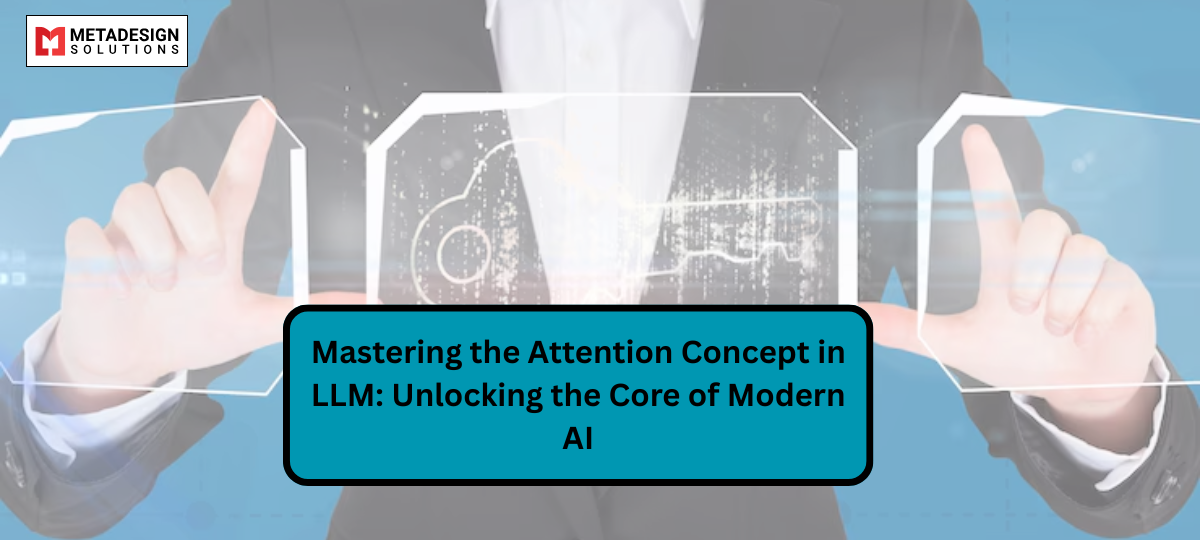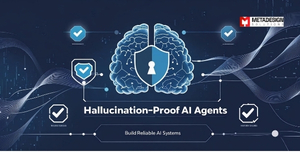Introduction to Attention Mechanism
What is Attention in NLP?
Attention is a concept borrowed from human cognition, where we focus on certain aspects of our environment while ignoring others. In natural language processing (NLP), attention mechanisms enable models to focus on specific parts of the input while performing tasks such as translation, summarization, or question-answering. The goal is to allow a model to weigh the importance of different words (or tokens) in a sequence when generating an output, helping the model understand context better. Businesses looking to implement cutting-edge attention mechanisms in their applications can leverage AI development services to build efficient and context-aware solutions tailored to their specific needs.
Before attention mechanisms, traditional models like RNNs (Recurrent Neural Networks) and LSTMs (Long Short-Term Memory) were used to process sequences of data. However, these models had limitations, especially in capturing long-range dependencies. Attention mechanisms solve this problem by allowing models to directly connect words in different parts of the sequence, regardless of their distance.
Why is Attention Important?
The significance of attention lies in its ability to allow models to focus on important parts of the input sequence. Traditional models like RNNs process data sequentially, which makes it difficult to learn long-range dependencies. Attention, on the other hand, provides a direct connection between input tokens, enabling the model to consider relationships between tokens that are far apart. This results in a better understanding of context and meaning, especially in tasks that require complex comprehension, such as long-form text generation or multi-turn dialogue systems.
How Attention Works in Language Models
Basic Principles of Attention
At its core, attention works by assigning a weight to each token in the input sequence. These weights are used to determine which tokens should be focused on when making predictions. This mechanism helps the model understand which parts of the input are most relevant for the task at hand. The attention mechanism allows the model to dynamically adjust which tokens to focus on, depending on the context.
The attention mechanism calculates a score for each token in the sequence, indicating its relevance to the token currently being processed. The higher the score, the more attention the model gives to that token when generating the output.
Key Components: Queries, Keys, and Values
In the attention mechanism, each token is transformed into three components:
- Queries (Q): These represent the token that the model is currently processing and are used to compare against other tokens to determine relevance.
- Keys (K): These represent the tokens within the sequence that the model compares the query against.
- Values (V): These represent the information that is associated with each token, which is eventually used to generate the output.
The query vector is compared to the key vectors to calculate the attention score. The value vectors, weighted by the attention scores, are then used to produce the output.
Scoring Mechanism
The scoring mechanism typically uses the dot product between the query and key vectors to determine how much attention should be given to each token. This result is then scaled (to avoid excessively large values) and passed through a softmax function to normalize the scores. The softmax function ensures that the attention scores sum to 1, meaning that each token’s weight is a proportion of the total attention.
Mathematically, the attention score for a token is computed as follows: Attention Score=Q⋅KTdk\text{Attention Score} = \frac{Q \cdot K^T}{\sqrt{d_k}} Where:
- QQ is the query vector,
- KK is the key vector,
- dkd_k is the dimensionality of the key vector.
After applying softmax to the scores, the final attention weights are used to compute a weighted sum of the value vectors to produce the output.
Partner with MDS for Advanced LLM Integration
Ready to revolutionize your AI projects? Connect with MDS to leverage our expertise in attention mechanisms and LLMs.
Types of Attention Mechanisms
Self-Attention
Self-attention is a mechanism where a token attends to other tokens in the same sequence. This allows the model to capture relationships between words, regardless of their position in the sequence. For example, in the sentence “The cat sat on the mat,” the token “cat” should focus on “sat” and “mat” to understand its context better. Self-attention makes it possible for the model to create contextualized embeddings for each token by considering the entire sequence at once.
This mechanism is the core of transformer-based models, enabling them to process all tokens in parallel and capture long-range dependencies effectively.
Cross-Attention
Cross-attention is used when the model needs to focus on another sequence while generating output. This is particularly useful in tasks like machine translation, where the decoder must attend to the encoder’s output while generating the translation. In this case, the query comes from the decoder, while the keys and values come from the encoder.
Cross-attention allows the model to combine information from different sources, making it essential for tasks that require multi-sequence input, such as text summarization and question answering.
Multi-Head Attention
Multi-head attention is an extension of the attention mechanism where multiple attention mechanisms (or heads) are applied in parallel. This allows the model to focus on different aspects of the input sequence simultaneously. Each attention head operates on different projections of the input, capturing diverse relationships between tokens.
Multi-head attention helps the model learn richer representations of the input sequence, as each head can capture different types of dependencies (e.g., syntactic vs. semantic) between tokens. The results from all heads are then combined to produce the final output.
Transformers and Attention
Role of Attention in Transformer Models
Transformers are built entirely around attention mechanisms, specifically self-attention. The transformer architecture consists of an encoder-decoder structure, where both the encoder and decoder use attention to process sequences in parallel. The encoder uses self-attention to create contextualized representations of the input sequence, and the decoder uses both self-attention and cross-attention to generate the output.
The attention mechanism in transformers is efficient because it allows all tokens in the sequence to be processed at once, rather than one at a time, as in RNNs. This parallel processing leads to faster training times and better scalability, especially for large datasets.
Attention in the Encoder-Decoder Architecture
The encoder-decoder architecture allows transformers to handle a variety of tasks, such as machine translation and summarization. In this setup:
- The encoder uses self-attention to process the input sequence, generating a sequence of contextualized representations.
- The decoder uses both self-attention (to process the partially generated output) and cross-attention (to attend to the encoder’s representations) to produce the final output.
This design enables transformers to handle complex tasks efficiently by directly linking different parts of the input and output sequences.
Benefits of Attention Mechanisms in LLMs
Improved Contextual Understanding
Attention mechanisms help models understand the context of words based on their relationships with other words in the sequence. This allows for a more nuanced understanding of meaning, particularly in sentences where the meaning of a word depends on the surrounding context. For example, in the sentence “I saw the man with the telescope,” attention mechanisms help the model understand whether the “man” has the “telescope” or if the “telescope” is the tool used to “see” the man.
Handling Long-Range Dependencies
One of the biggest advantages of attention mechanisms is their ability to handle long-range dependencies. Unlike RNNs, which struggle with remembering long-term information due to their sequential nature, attention allows for direct connections between distant tokens in the sequence. This makes attention-based models better suited for tasks involving long sequences, such as document summarization or long-form question answering.
Parallelization of Computation
Since the attention mechanism processes all tokens in parallel, it can be efficiently parallelized across multiple processors. This leads to faster training and inference times, making attention-based models scalable and effective for large-scale NLP tasks. Unlike RNNs, which process tokens sequentially, attention mechanisms allow for the simultaneous processing of all tokens in the input sequence, leading to significant speedups in computation.
Attention in Large Language Models (LLMs)
Attention in BERT, GPT, and T5 Models
- BERT: BERT (Bidirectional Encoder Representations from Transformers) uses a bidirectional attention mechanism, meaning it looks at both the left and right context of a word simultaneously. This bidirectional approach allows BERT to understand the full context of a word, making it highly effective for tasks like question answering and text classification.
- GPT: GPT (Generative Pretrained Transformer) uses a unidirectional (causal) attention mechanism, meaning it only looks at the previous tokens when generating text. This approach is ideal for tasks like text generation, where the model generates text one token at a time based on prior context.
- T5: T5 (Text-to-Text Transfer Transformer) treats every NLP task as a text-to-text problem. T5 combines both self-attention and cross-attention mechanisms to handle a wide variety of tasks, including translation, summarization, and question answering.
Differences in Attention Mechanism Across Models
While BERT, GPT, and T5 all rely on attention mechanisms, their use differs in the way they handle context. BERT is designed for understanding context in both directions, GPT focuses on generating text in a unidirectional manner, and T5 combines the strengths of both approaches by framing all tasks as text generation problems.
Visualizing Attention
Heatmaps and Attention Maps
Attention maps are visual representations of where a model focuses during the prediction process. By visualizing these maps, we can see which tokens the model considers important when generating a response. Heatmaps, where areas of high attention are highlighted in warmer colors, are commonly used to visualize attention.
How Attention Visualization Helps Interpret LLMs
Visualizing attention can help practitioners interpret the reasoning behind the model’s predictions. By inspecting attention maps, we can identify whether the model is focusing on the right parts of the input. This is particularly important in applications where interpretability is crucial, such as medical or legal domains.
Challenges and Limitations of Attention in LLMs
Computational Complexity
One of the main challenges of attention is its computational complexity. The time complexity of the attention mechanism is O(n²), where n is the sequence length. This means that the cost increases quadratically with the length of the input sequence, making it difficult to process long sequences efficiently. Techniques like sparse attention are being developed to mitigate this issue.
Memory Usage
Attention mechanisms require storing large matrices, especially in models with long input sequences. This can lead to high memory usage, which poses challenges for training on limited hardware resources. Optimizations like memory-efficient attention are being explored to address this issue.
Limitations in Long Sequences
While attention mechanisms are better at handling long-range dependencies than traditional models, they still struggle with very long sequences. As the sequence length increases, the memory and computation required for attention grows quadratically, which can limit the scalability of models for extremely long texts.
The Future of Attention Mechanisms in LLMs
Optimizations for Efficiency
Researchers are exploring various techniques to make attention mechanisms more efficient. These include sparse attention, low-rank approximations, and memory-efficient attention, all aimed at reducing the computational and memory overhead of attention-based models.
Beyond Transformers: New Architectures
While transformers have dominated the field of NLP for the past few years, new architectures are being proposed that build on or extend attention mechanisms. These include models like RNN-augmented transformers, which aim to combine the strengths of both recurrent networks and attention.
Future Directions in Attention Research
Future research in attention mechanisms will likely focus on improving efficiency, interpretability, and scalability. As Large Language Models (LLMs) continue to grow in size and capability, optimizing attention mechanisms will be critical for enabling faster and more efficient models. Businesses seeking to harness the power of attention-based architectures can benefit significantly from LLM development services tailored to their specific needs.
By partnering with experts in LLM development services, organizations can implement cutting-edge solutions that maximize the efficiency of attention mechanisms, ensuring seamless performance even for large-scale applications. Whether it’s reducing computational complexity, exploring sparse attention techniques, or enhancing memory efficiency, these services enable businesses to stay ahead in the rapidly evolving AI landscape.
Conclusion
Recap of Key Concepts
In this blog post, we explored the concept of attention mechanisms in large language models. We discussed how attention allows models to focus on important parts of the input sequence, enabling better contextual understanding and handling of long-range dependencies. We also covered the different types of attention, including self-attention, cross-attention, and multi-head attention, and their roles in transformer-based architectures like BERT, GPT, and T5.
The Importance of Attention in LLMs
Attention mechanisms have revolutionized NLP by providing a way for models to process sequences in parallel, capture complex dependencies, and scale to large datasets. Their importance in large language models cannot be overstated, as they enable the models to achieve state-of-the-art performance across a wide range of tasks.
Related Keyphrase:
#AttentionMechanism #LargeLanguageModels #LLM #Transformers #SelfAttention #CrossAttention #MultiHeadAttention #NLP #NaturalLanguageProcessing #AI #MachineLearning #DeepLearning #BERT #GPT #T5 #AIResearch #AIDevelopment #DataScience #ArtificialIntelligence #AIDevelopmentCompany #TechInsights #NeuralNetworks #LanguageModels #AIInnovation #DataEngineering #TechBlog #FutureOfAI #AIExplained #AIApplications #NLPApplications



